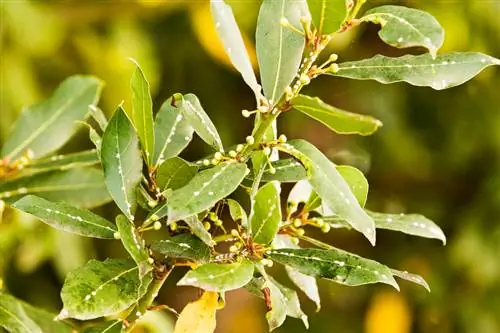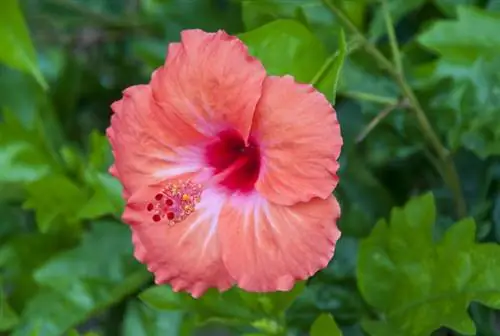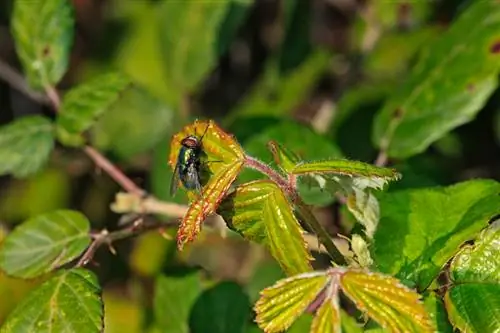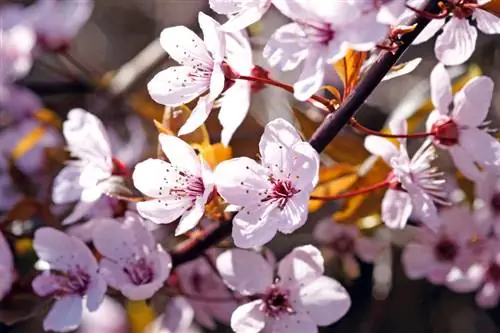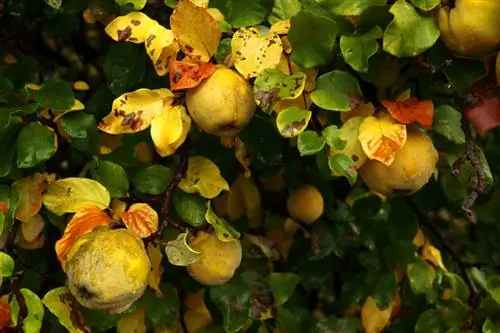- Author admin [email protected].
- Public 2023-12-16 16:46.
- Last modified 2025-01-23 11:22.
The real laurel (Laurus nobilis) is also known in this country as spice laurel because its leaves are harvested for use in the kitchen. When it comes to the various types of damage to the plant, a distinction must be made between deficiency symptoms caused by inappropriate care and diseases.
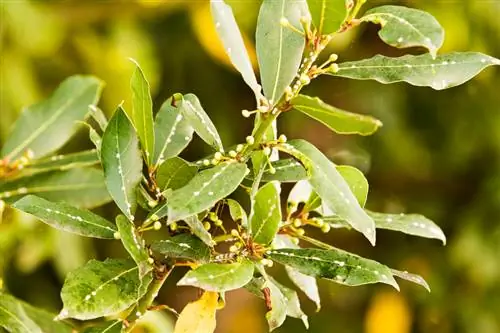
What diseases can affect the laurel?
Possible diseases of the laurel include shotgun disease and pest infestations (spider mites, scale insects and mealybugs). A suitable location, reduced nitrogen fertilization, moderate winter temperatures and, in the event of an infestation, collecting or washing away the pests help preventively.
| Illness | Symptoms | Measures |
|---|---|---|
| Shotgun disease | More common in cherry laurel; Real laurel is usually resistant | Fungicide sprays, reduced nitrogen fertilization |
| Powdery mildew | White, mealy coating on the leaves, possible leaf fall | Good air circulation, avoidance of drought stress, regular control, fungicides |
| Downy mildew | Fungal infestation on the underside of the leaves, oily, yellowish sheen on the leaves | Removal of infected leaves, fungicides, good air circulation, balanced irrigation, avoidance of waterlogging |
| Leaf edge necrosis | Brown or black discoloration on the edge of the leaf | Adapted fertilization, adequate irrigation, use of soft water |
Diseases of the laurel
Shotgun disease on laurel
The so-called shotgun disease is regularly mentioned in connection with laurel, but it is more likely to affect the cherry laurel used for hedges than the real laurel. Fungicide sprays and reduced nitrogen fertilization are recommended as measures against the disease. In addition, the real laurel (Laurus nobilis) is a relatively resistant plant that is hardly prone to disease.
Powdery mildew on laurel
Another disease that can affect laurel plants is powdery mildew. It can be recognized by a white, mealy coating on the leaves, which, if the infestation is advanced, can lead to leaf deformation and ultimately leaf fall. Powdery mildew occurs primarily in warm, dry weather. Good air circulation, the avoidance of drought stress and regular control of the plants help to detect and treat an infestation early, for example by using suitable fungicides.
Downy mildew on laurel
Downy mildew, often confused with powdery mildew, is different in that the fungal attack occurs on the underside of the leaves and they have an oily, yellowish sheen. If infested, affected leaves should be removed and the plant treated with a fungicide. Good air circulation, balanced watering and avoiding waterlogging also have a preventive effect here.
Leaf edge necrosis on laurel
Leaf edge necrosis is another disease that can occur in laurel. It manifests itself as brown or black discoloration on the edge of the leaf, which can spread inwards. The cause is often excessive calcium intake or a lack of certain nutrients such as magnesium. Adjusted fertilization, adequate but not excessive watering and the use of soft water can help prevent or correct this problem.
Pests on laurel
In rare cases, the spice laurel can be infested with spider mites, scale insects and mealybugs. You can recognize scale insects by their spotted leaves and spider mites by their fine webs. Mealybugs leave a kind of white fuzz on the leaves. Since the laurel can only be overwintered outdoors in mild locations in this country, it often spends the winter in warm, dry winter quarters. To ensure that pest infestation is less likely, the temperature should not exceed 8 degrees Celsius and you should winterize the laurel plants as late as possible and leave them early again. Increased humidity can also help prevent spider mite infestation.
Tip
If you have a pest infestation of laurel, try to remove the insects that are sitting on them by collecting them or washing them with a sharp jet of water. The use of appropriate insecticides makes the leaves taboo for harvesting and consumption for months or years.
Black weevil on the laurel
The black weevil can also attack a laurel. Typical symptoms include feeding damage to the leaves and possibly yellow discoloration. For prevention, it is recommended to regularly examine the plant for signs of infestation and use pesticides if necessary. To combat the black weevil, nematodes can be used, which are microscopic roundworms that parasitize the larvae of the weevil. The use of nematodes is an environmentally friendly method that is particularly suitable for use in the garden.
Deficiency symptoms of the leaves and roots of the spice laurel
Due to its southern origins, the real laurel prefers a sunny location with permeable soil. If it is planted outdoors in a shady spot with heavy, wet soil, stunted growth or leaves falling off can occur, even with otherwise good care. If brown leaves or leaves appear without cutting the plant, the reason for this may be an over- or under-supply of water. This can be recognized when transplanting the laurel by the hairy roots that are either dried out or slightly rotten. In a sufficiently large pot, laurel should be watered at least once a week in dry conditions, but you should also avoid waterlogging. Since the spiced laurel reacts sensitively to s alts, you should only fertilize it sparingly and, if possible, with organic fertilizer.

